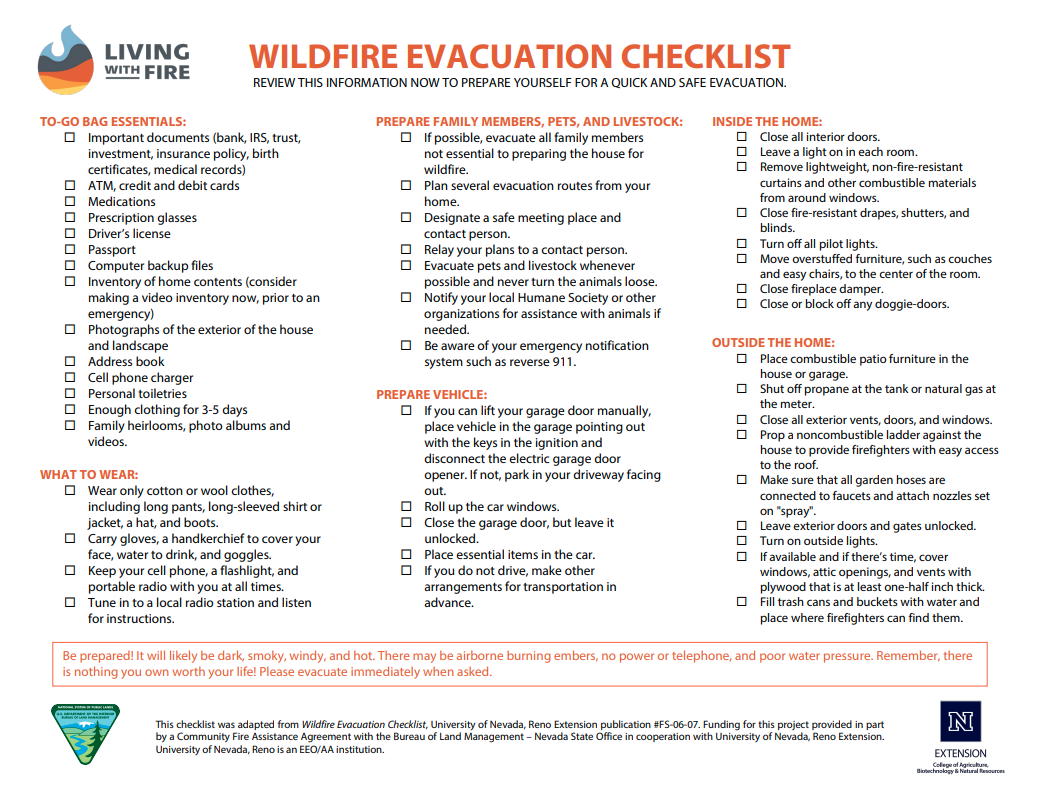Press release from the Humboldt County Office of Emergency Services:
𝗡𝗘𝗪 𝗘𝗩𝗔𝗖𝗨𝗔𝗧𝗜𝗢𝗡 𝗢𝗥𝗗𝗘𝗥 issued for zone HUM-E063-A, south of Willow Creek. Residents in this zone should evacuate now. There is no immediate threat to Willow Creek proper.
𝗭𝗢𝗡𝗘 𝗗𝗘𝗦𝗖𝗥𝗜𝗣𝗧𝗜𝗢𝗡
HUM-E063-A
NORTH OF Forest Route 6n39
SOUTH OF Friday Ridge Road
EAST OF Friday Ridge Road, Forest Route 6n08a
WEST OF Friday Ridge Road

Wildfire Evacuation Checklist and more:
When an evacuation is anticipated, follow these checklists (if time allows) to give your home the best chance of surviving a wildfire.

Home Evacuation Checklist – How to Prepare for Evacuation:
Inside the House
-
- Make sure you know your community’s emergency response plan and have a plan on where to go when it is time to evacuate, and best routes for leaving your location.
-
- Shut all windows and doors, leaving them unlocked.
-
- Remove flammable window shades, curtains and close metal shutters.
-
- Remove lightweight curtains.
-
- Move flammable furniture to the center of the room, away from windows and doors.
-
- Shut off gas at the meter; turn off pilot lights.
-
- Leave your lights on so firefighters can see your house under smoky conditions.
-
- Shut off the air conditioning.
Outside
-
- Gather up flammable items from the exterior of the house and bring them inside (patio furniture, children’s toys, door mats, trash cans, etc.) or place them in your pool.
-
- Move propane BBQ appliances away from structures.
-
- Connect garden hoses to outside water valves or spigots for use by firefighters. Fill water buckets and place them around the house.
-
- Don’t leave sprinklers on or water running, they can affect critical water pressure.
-
- Leave exterior lights on so your home is visible to firefighters in the smoke or darkness of night.
-
- Put your Emergency Supply Kit in your vehicle.
-
- Back your car into the driveway with vehicle loaded and all doors and windows closed. Carry your car keys with you.
-
- Have a ladder available and place it at the corner of the house for firefighters to quickly access your roof.
-
- Seal attic and ground vents with pre-cut plywood or commercial seals.
-
- Patrol your property and monitor the fire situation. Don’t wait for an evacuation order if you feel threatened.
-
- Check on neighbors and make sure they are preparing to leave.
Animals
-
- Locate your pets and keep them nearby.
-
- Prepare farm animals for transport and think about moving them to a safe location early.
-
- Pets: https://www.livingwithfire.com/get-prepared/
Prepare for Pets
Prepare to address the needs of your pets if you have to evacuate.
-
- Make sure dogs and cats wear properly fitted collars with identification, vaccination, microchip and license tags.
-
- Your pet evacuation plan should include routes, transportation needs and host sites. Share this plan with trusted neighbors in your absence.
-
- Exchange veterinary information with neighbors and file a permission slip with the veterinarian authorizing emergency care for your animals if you cannot be located.
-
- Make sure all vehicles, trailers and pet carriers needed for evacuation are serviced and ready to be used.
-
- Assemble a pet to-go bag with a supply of food, non-spill food and water bowls, cat litter and box and a restraint (chain, leash or harness). Additional items to include are newspaper and paper towels, plastic bags, permanent marker, bleach/disinfectant solution and water buckets.
![]()
![]()
![]()
![]()
[ad_2]
Originally Appeared Here